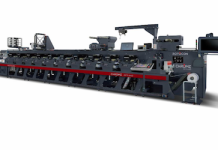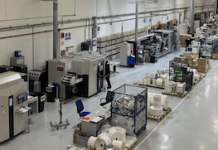Printing SA has been very proactive in responding to their members’ challenges and questions around lockdown. As such, Africa Print and Printing SA recently held a free webinar on 30 April aimed to give an update on the issues around Covid-19 that affect our industry and answer questions from the industry.
The webinar addressed topics from risk levels of printing, applying for permits for essential services, keeping and paying current staff and TERS fund submissions from UIF and more. It also included an update on the latest points raised by the President on 23 April and how this impacts the printing and packaging industries.
Attendees had an opportunity to ask the panellists questions. Those who couldn’t attend can watch the full length webinar here.
The webinar was moderated by Meggan McCarthy, editor of Africa Print.
Each of the four panellists were asked the following questions:
Dr Abdool Majid Mahomed, CEO of Printing SA www.printingsa.org
Q. Recently the the Department of Trade and Industry (dti) announced the partial lifting of the lockdown to Level 4, allowing some industries and sectors to come back into service. What has Printing SA done to represent the needs of companies within the manufacturing sector? By when will the dti respond to all the submissions made?
Printing SA has been hard at work dissecting every piece of legislation, and government gazettes that have been issued over the past five weeks. There has been a raft of regulations and we have thoroughly analysed each document and inspected what related to the elements which member companies really needed.
We have been aggressively sending out at least two items of communication weekly containing this valuable information. The ministry of COGTA developed a Covid-19 risk adjustment strategy schedule of services document describing five phases of how the lockdown will be lifted. Under level 5, all manufacturing related essential food production, medical and hygiene supplies as well as pharmaceutical products were already allowed.
Level 4, which kicks in on 1 May, allows for the partial lifting of additional manufacturing to start. COGTA and the dti have utilised Stats SA’s standard classification of industry codes (also called the SIC codes); there’s a framework for which it explains which sectors will become operational and to what degree in percentages.
This document was released on Saturday last week and the businesses and industry bodies were given a mere 48 hours to respond. Our team at Printing SA analysed it – looking at our entire value chain of production as it relates to printing, packaging and signage.
We started off looking at the pulp production from trees from which paper and boards are manufactured, into products which are used by all sectors transversely (books, magazines and other media) and packaging of products and signage and advertising used.
This entire array of products were categorised into a list of 58 products that our member companies produce. We then married this list with the SIC codes published and found the following:
In section A, which included agriculture, hunting, forestry and fishing, the dti has now allowed logging under forestry to be fully operational under level 4. This means that the manufacturing of papers and board will start up in earnest.
In section C which is manufacturing, the manufacture of paper and products as well as the manufacturing of packaging as it is related to essential products was already opened up. Now under level 4, it includes other manufacturing sectors related to our industry, in particular, division 17, which relates to the manufacture of paper and paper products; 18 that deals with printed products and recorded media; 58 which has published activities such as books, magazines etc.; 73 is advertising and market research; 74 which concerns other professionals’ scientific and technical activities and 82, which covers office administration, office support and other business activities like stationery, etc.
The document risk adjusted schedule states the percentage degree to which sectors can start up. Our considered opinion was that now up to 20% was possible from 1 May with the exception of stationery, which will go up to 50%.
Our opinion has been based on the spirit of this document, which states that due consideration has to be given to ensure that the partial lifting will only allow for the slow and phased in upscaling of our operations to get the economy going again, while keeping the focus on reducing the threat of the spread of Covid-19.
We therefore responded to dti stating our understanding to be 100% for essential services support, 20% for all other manufacturing and 50% for stationery-related production. We have requested the dti to either confirm our understanding, or if we have misinterpreted anything, to rectify this in writing, which we will then forward to all our member companies.
In addition, Printing SA has also developed an industry wide risk assessment industry policy allying to both the department of economic and labour’s Covid-19 2020 regulation, and the occupational health and safety act. It covers all key elements for companies resuming operations. Companies can use this as a tool. This document also includes what they should have in terms of PPE, how to implement social distancing, signage that has to be used and much more.
This risk assessment, if carried out systematically, forces detailed planning before operations can resume on Monday and this document will be available for use shortly from our website. Another challenge is how many staff are required for use of a machine and whether shift work is possible to avoid too many employees from being in close proximity to each other.
The lockdown command acknowledged the receipt of our submission. Minister Ebrahim Patel has also acknowledged a receipt of our submission, and we will announce their response as soon as it becomes available. Going forward, we plan to engage more with the dti.
Q. What can print and packaging companies register and apply for in terms of tax and any other financial relief? Have these been effective?
As over 75% of our member companies consist of SMMEs let me start off with (some of) the financial relief options available to them. The department of small business development have a number of agencies geared up to support this vital sector. There’s a Small Enterprise Development Agency (SEDA) and the Small Enterprise Finance Agency (SEFA). Information for what they have to offer is on the DSBA website.
There is also the SMME debt relief finance agency, which allows registered companies debt relief of a maximum period of six months. There is also the SMME growth resilience facility for the informal sectors not registered as tax payers, and there has also been some relief measures announced recently.
All financial institutions and banks have relief measures for companies in good standing. For larger companies, there is the national empowerment fund that assists with financial support. National treasury and SARS has also announced the disaster management tax relief bill. Are they effective? It is difficult to answer as it differs from company to company, as each are unique.
Q. The Minister of Employment and Labour has announced the Covid-19 Temporary Employer-Employee Relief Scheme (Covid-19 TERS) to contribute to the containment of the pandemic. What measures has Printing SA put in place to assist employers?
Printing SA is trying to make sense of the TERS scheme. There is a desperate need for a step by step guide, which was devised on 9 April. We gave guidance of a minimum wage – R3598 per month or R20.78 per hour. Revised legislation was passed and released on 21 April. We are going to publish the next iteration soon.
Q. Will there be longer-term disruptions and shifts in print demand and printer operations? Is there any research to back the trends that may unfold?
Most definitely. There were two research papers produced recently. BMI has done research on industry strategy as requested by the FP&M SETA.
Their main findings were:
– That digital print will become more popular, and that cost, quality and shorter lead times will be top priorities.
– Employees will continue to have jobs provided they adapt and change, having to reskill and upskill themselves.
– Digitisation will result in more integrated partnerships and collaboration with digital experts.
Other research conducted by the Futures Research from Stellenbosch University identifies forces influencing the printing industry:
– Changing customer attitudes.
– Changes in business models and the economy at large.
– Supply and value chain offering is in a state of flux.
– Sustainability will be top of mind.
Tommie du Sart, CEO Renform www.renform.co.za
Q. Has your company been open during this lockdown, and what services have you offered?
We have been running but have been very limited. We are fortunate that we supply diversified products for the medical, banking, POS and food packaging sectors. We are running with limited staff, with masks and sanitiser supplied.
Q. What are the challenges around supplying an essential service like printing with law enforcement, stock, delivery and staff?
Our staff were scared of contracting the virus at first, but have settled down as the facts became available. Stock containers were late by a few weeks, and there has been lots of red tape when it comes to motivating why they are essential items. We are settling down by using the right certificates. Once the right documents are in place, there is no problem after that.
Our biggest fear is that law enforcement will have their own interpretation as to what essential services are, as these are open to interpretation. We are intertwined with many industries, which has has a knock-on effect for most people. Staff have had issues with taxis, and hand-work is an issue with social distancing in confined areas. Managing the distances will be a challenge for most printing companies.
Jerome Morkel, Managing Director of Tandym Print www.tandym.co.za
Q. We know the negative financial impact Covid-19 has inflicted on all companies and individuals. Any advice on what should be focused on when companies re-open for business?
Work hard to ensure the welfare of staff. Communication is key, so speak to your staff, suppliers and stakeholders. Realism must be be translated to your staff.
Make arrangements with your suppliers, buy time, get processes running, get cashflow running again, keep talking and maybe suggest a settlement discount. I’ve prioritised paying smaller suppliers as they are in survival mode. We’re pushing as hard as we can. There is also the 5% rule – i.e do 5% more than you did yesterday, as it can have a multiplying effect.
Q. There are many small companies that are shut down during this time. What advice can you give on what they can do during this time to be productive? Can you share any examples of those who have innovated and adapted their businesses throughout lockdown and survived?
Take time to meet as senior management, rethink business models and do research. Our knowledge base has increased in doing this. For the sales guys: generate more prospect lists, and plan for when the lockdown lifts. Refine marketing plans and get new corporate profiles. These little things will help you to get ready for a new start. Ride out this wave, and appeal to your staff to keep pushing through.
Andrew Read, Regional HR manager at Bidvest Data, Print & Packaging www.bidvestpaperplus.co.za
Q. Has the TERS and UIF processes provided relief, and what has been your experience in this regard?
The first experience that a lot of people encountered is that the processes were not particularly streamlined or planned properly for submissions of claims by employees. That has been resolved.
By 24 April, there were 37,000 companies that had been been paid their TERS money so the system seems to be working well. Payments have been made, but schedules have not been submitted. Lots of employers are working through that. TERS does give some relief to employees, and this applies to all employees.
Q. It seems inevitable that some companies will have to retrench and restructure going forward, what advice can you give companies that may being making these considerations and how are you as an organisation managing the retention and redundancy of staff?
There are opportunities available. Short time can take on many forms, i.e one team working one week, and another team another week etc., or work 40% of normal hours. Keep as many people in the economy as you can, the more people the better, even if there is reduced spending. Retrenchment is a last resort, because we are not sure what the future holds. The message has gotten out that it’s a time for survival, not demand, and people are accepting that.
Deon Joubert, CEO of Merpak Envelopes and former President of PIFSA www.merpak.co.za
Q. It’s very important to be focused on the future. I hear many iterations that the world will be different and we need to do things differently going forward. What does this mean for the printing, packaging and signage industry? Will it need to change?
Nobody knows really. What we do know is that the printing industry over the centuries has had to face change, and it has. Some sectors will be better off than others, with supply and demand affected differently. So we need need to face up to change.
Q. With level 4, exports will resume, how can companies ready themselves to effect this, considering that disruptions have occurred across the supply chain?
Buy locally, and stop relying on printed imports. Reinforce that message. Let’s start educating our consumers that we can print locally. We need to export – not all of us can but I don’t see any concerns about pushing export, it’s a great opportunity.
Positive parting shot from each panellist:
Mahomed: Covid-19 has caused tectonic shifts, so we are moving into a new paradigm.
Du Sart: Diversify more, use equipment to make different products, and embrace opposition, ie, collaborate with them.
Morkel: Take a humble approach to staff, clients and suppliers. All the best to those in the industry!
Read: There is a new order coming and we need to work accordingly. Look at what we’ve lived through: two world wars, the Spanish flu, we’ve been through so much, and humans are adaptable and flexible.
Joubert: A crisis like this brings out the best and worst of us. Be kind to each other. We’re not alone. Good luck to everybody.
A list of FAQs that Printing SA has received and answered can be found here: https://printingsa.org/covid-19-lockdown-faqs-for-the-printing-packaging-signage-and-visual-communication-sector/.
Additionally, Printing SA has heeded the call from the industry and has submitted representation to the Minister of dti Ebrahim Patel, as the team had listened carefully to his address to the nation on Saturday 25 April 2020, notifying them of the sectors that have been accommodated under the new regulations and have studied the draft schedule of services to be phased in as per the Covid-19 risk-adjusted strategy.
Printing SA believe that very few of the essential services and/or goods listed under Level 5 lockdown would be able to function efficiently without the involvement of its member companies in the printing, packaging, signage and visual communication industry.
The association has compiled a list of all the products manufactured in our industry, touching on all the key industries listed from category A to Category Q. Printing SA has sought clarity to this contentious issue and appealed to the department for feedback which you can read here: https://printingsa.org/wp-content/uploads/2020/04/Letter-to-Minister-Patel.pdf
Further to its motivation, Printing SA drafted an Industry Risk Assessment Policy document that is available to its members as a guide for how they are to operate during the various stages of lockdown. The document was compiled in consultation with the industry and seeks to highlight key measures that companies that will be open during these stages need to comply with in order to meet the regulations as set out by COGTA.
This document looks at additional rules pertaining to sectors and firms before any sector resumes activity. The following conditions must be in place:
In addition to generally applicable health and safety protocols, each sector must agree upon a COVID-19 prevention and mitigation plan with the Minister of Employment and Labour, the Minister of Health and any other Minister relevant to the sector.
Individual businesses or workplaces must have COVID-19 risk assessments and plans in place, and must conduct worker education on COVID-19 and protection measures:
-Identification and protection of vulnerable employees.
-Safe transport of employees.
-Screening of employees on entering the workplace.
-Prevention of viral spread in the workplace:
– Cleaning of surfaces and shared equipment.
– Good ventilation.
– Managing sick employees.
Monitoring systems must be in place to ensure compliance with safety protocols and identify infections among employees. The full document can be downloaded here https://printingsa.us16.list-manage.com/track/click?u=1e22c3e7fd04ad04970b76ebf&id=0ac847b2bb&e=4f25eeac43
To submit your news please, contact journo@practicalpublishing.co.za
Read the top 5 stories weekly on WhatsApp or sign up to our newsletter.
PRINTING SA
+27112871160
info@printingsa.org
http://www.printingsa.org





















